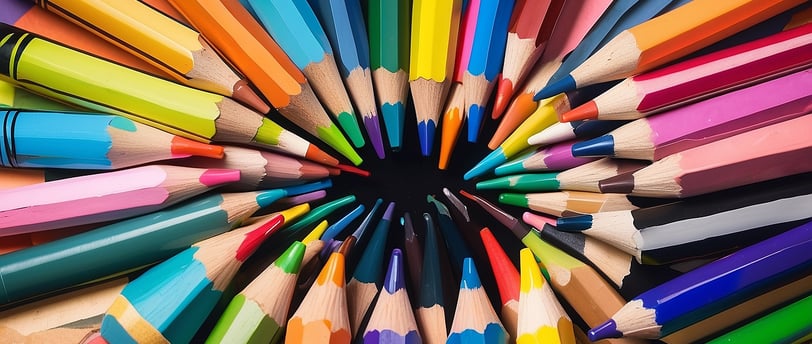What Additional Accessories Should Beginners Consider for Coloring?
A Comprehensive Guide
12/28/20233 min read


Introduction
When starting out in the world of coloring, it's not just the primary tools like crayons, pencils, or markers that matter. Beginners should also consider a range of additional accessories to enhance their coloring experience. This post will explore essential and beneficial accessories for beginners in coloring, ensuring a more enjoyable and effective journey into this creative hobby.
1. The Importance of the Right Accessories
Accessories can significantly enhance the coloring process, making it more enjoyable, efficient, and even more professional. They can range from practical items for maintaining your tools to creative aids that help expand your coloring techniques.
2. Paper Quality: The Foundation of Coloring
Choosing the Right Paper: The type of paper you color on can impact the final outcome. Thicker, high-quality paper is ideal, especially if using markers or watercolors, to prevent bleeding and allow for better color saturation.
Sketchbooks and Printing Paper: For those who prefer digital coloring pages, a good quality printing paper is essential. Alternatively, a sketchbook with high-grade paper can be a great way to keep your artwork organized.
3. Sharpeners: Keeping Pencils in Prime Condition
Types of Sharpeners: A good sharpener is crucial, especially for colored pencils. Manual sharpeners with adjustable blades or electric sharpeners are both suitable choices.
Sharpening Tips: Regular sharpening ensures precision in coloring, but be gentle to avoid breakage.
4. Erasers: For Correction and Special Effects
Variety of Erasers: Beginners should consider erasers not just for correcting mistakes but also for creating effects like highlighting or softening colors.
Recommended Types: Plastic erasers are great for clean erasing, while kneaded erasers can be molded for precise erasing or creating textures.
5. Blending Tools: Creating Seamless Transitions
Purpose of Blending Tools: Blending tools help in merging colors smoothly, crucial for achieving depth and dimension in your artwork.
Types of Blending Tools: Paper stumps, blending pencils, and even cotton swabs can be used effectively for blending.
6. Rulers and Stencils: For Precision and Creativity
Use of Rulers: A ruler can be handy for creating straight lines or geometric patterns.
Stencils: Stencils are great for adding intricate patterns or designs, especially useful for beginners not comfortable with freehand drawing.
7. Storage Solutions: Keeping Your Tools Organized
Importance of Proper Storage: Good storage solutions not only keep your tools organized but also protect them from damage.
Storage Options: From pencil cases to storage boxes, choose a storage method that suits the quantity and type of your coloring tools.
8. Color Wheels: Understanding Color Theory
A Color Wheel for Beginners: A color wheel is an invaluable tool for understanding color relationships and combinations, particularly helpful for beginners in developing an eye for color schemes.
9. Protective Gear: Preserving Your Art and Workspace
Workspace Protection: Consider a desk mat or cover to protect your workspace from stains or scratches.
Artwork Protection: Using fixatives (for certain mediums) can protect finished artwork from smudging or fading.
10. Lighting: Ensuring the Right Visibility
Importance of Good Lighting: Proper lighting is crucial to avoid eye strain and to see colors accurately.
Natural and Artificial Light Sources: Ideally, work in a well-lit area with natural light, but if that’s not possible, invest in a good desk lamp.
11. Reference Materials: Guiding Your Artistic Journey
Books and Guides: Art books, coloring guides, and even online tutorials can be excellent resources for learning new techniques and getting inspiration.
12. Magnifying Tools: For Detailed Work
Magnifying Glass or Lamp: If you enjoy working on detailed coloring pages, consider a magnifying tool to ease the strain on your eyes.
13. Digital Applications: Expanding Your Coloring Horizons
Digital Coloring Tools: For those interested in digital coloring, software and apps like Adobe Photoshop or Procreate can offer a whole new world of possibilities.
14. Comfort Accessories: Enhancing the Coloring Experience
Ergonomic Tools: Ergonomic grips for pencils or chairs that provide good back support can make coloring sessions more comfortable, especially for longer durations.
Final Thoughts
For beginners in coloring, investing in these additional accessories can significantly enhance the experience. From practical tools like sharpeners and erasers to creative aids like blending tools and stencils, each accessory plays a role in making your coloring journey more enjoyable and fulfilling.
While the primary focus for beginners might be on the coloring tools themselves, the right accessories can make a big difference. They not only aid in the practical aspect of coloring but also contribute to developing your skills and style in this artistic hobby. Remember, the best accessories are those that cater to your specific needs and enhance your personal coloring experience.
Frequently Asked Questions
1. What are the must-have accessories for beginners in coloring?
2.What should I consider when choosing a sharpener for colored pencils?
